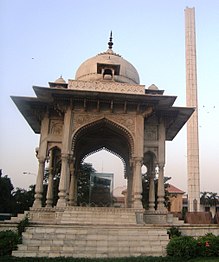User:Amarissaostmo/sandbox
 | This is a user sandbox of Amarissaostmo. You can use it for testing or practicing edits. This is not the sandbox where you should draft your assigned article for a dashboard.wikiedu.org course. To find the right sandbox for your assignment, visit your Dashboard course page and follow the Sandbox Draft link for your assigned article in the My Articles section. |
Article Evaluation: Urdu[edit]
Main Section Addition[edit]
Religious, social, and political factors pushed for a distinction between Urdu and Hindi in Northern India, leading to the Hindi–Urdu controversy. [1][2]
Cultural Identity and Islam[edit]
Colonial India[edit]
Religious and social atmospheres in early nineteenth century India played significant roles in the development of the Urdu register. In addition to Islam, India was characterized by a number of tribal religions which each represented different spiritual outlooks and maintained different languages. These tribal religions were later categorized by British colonialists as Hinduism. Under British rule, the dispersed tribes associated with Hinduism pushed for unification by means of a common language. Hindi became the distinct register spoken by those who sought to construct a Hindu identity in the face of colonial rule. [2] As Hindi separated from Hindustani to create a distinct spiritual identity, Urdu, which was originally spoken by both Hindu and Muslim elites, was employed to create a definitive Islamic identity for the Muslim population in India.[3]
As Urdu and Hindi became means of religious and social construction for Muslims and Hindus respectively, each register developed its own script. According to Islamic tradition, Arabic, the language spoken by the prophet Muhammad and uttered in creation of the Qur'an, holds spiritual significance and power.[4] Because Urdu was intentioned as means of unification for Muslims in Northern India and later Pakistan, it adopted an Arabic script.[5][2]

Pakistan[edit]
Urdu continued its role in developing a Muslim identity as the Islamic Republic of Pakistan was established with the intent to construct a homeland for Islamic believers.[6] Several languages and dialects spoken throughout the regions of Pakistan produced an imminent need for a uniting language. Because Urdu was the symbol of Islamic identity in Northern India, it was selected as the national language for Pakistan. While Urdu and Islam together played detrimental roles in developing the national identity of Pakistan, disputes in the 1950's challenged the necessity for Urdu as a national symbol and it's practicality as the lingua franca. The significance of Urdu as a national symbol was downplayed by these disputes when English and Bengali were also accepted as official languages. In addition to the disagreements over the value of Urdu as a national language in Pakistan, recent Muslims in Asia question the necessity for the Urdu script to be distinctly different from the Hindi script. While early nineteenth century Muslims saw the Arabic script as detrimental to their identity, certain modern Muslims choose to use a modified Hindi script in writing Urdu. [1] Although Urdu was a distinct identity marker for Muslims in colonialist ruled India and a national symbol for Pakistan, it's necessity has been put into question by modern Muslims in both India and Pakistan.
- ^ a b Ahmad, Rizwan (2008-07-01). "Scripting a new identity: The battle for Devanagari in nineteenth century India". Journal of Pragmatics. 40 (7): 1163–1183. doi:10.1016/j.pragma.2007.06.005.
- ^ a b c Agnihotri, Rama Kant. Tariq Rahman – From Hindi to Urdu: A social and political history. doi:10.1515/9783110279757.109.
- ^ Rahman, Tariq (1997). "The Urdu-English Controversy in Pakistan". Modem Asian Studies: p. 177-207 – via National Institute of Pakistan Studies, Qu.aid-i-Az.am University.
{{cite journal}}:|pages=has extra text (help) - ^ Schimmel, Annemarie (1992). Islam: an introduction. Albany, New York: State U of New York Press.
- ^ Ahmad, Rizwan (2011). "Urdu in Devanagari: Shifting orthographic practices and Muslim identity in Delhi". Language in Society.
- ^ Esposito, John (1996). Islam and Democracy. Oxford University Press. pp. 102–103.
